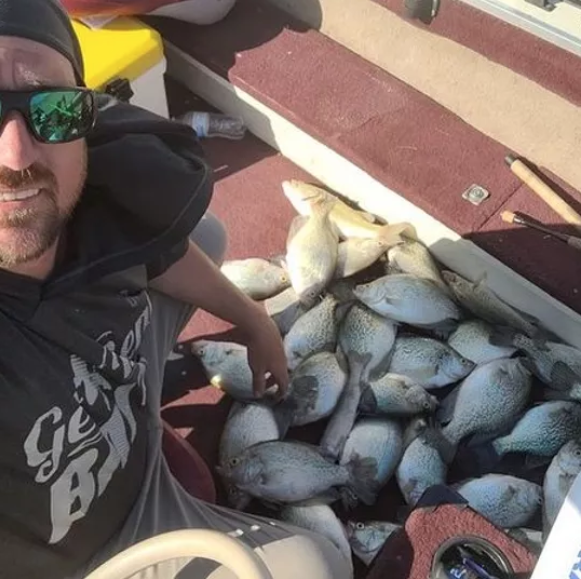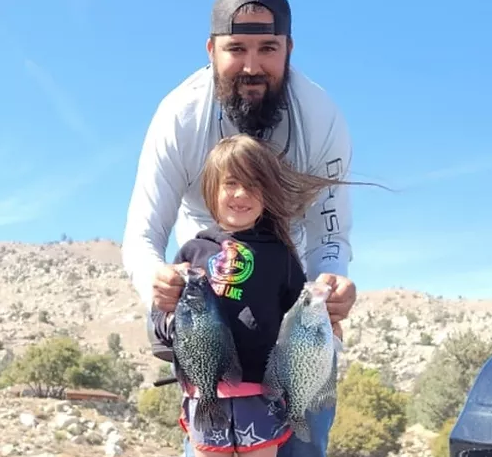
BY KATE STEWART
Cope’s Tackle and Rod Shop
BAKERSFIELD – Fishing for crappie and other panfish can be a great way to get into fishing. Especially when you are trying to involve young anglers. Crappie are typically found in schools and are easier to catch in numbers than other species of fish. They also are a favorite to put on the table. However, once they move out of the shallows during the spring spawn, without expensive electronics, and even sometimes with them, they can be a frustratingly difficult fish to target.
Here are some tips to help you locate this exciting species of fish in all bodies of water and to help you catch crappie during the warmer summer months.
- Look For Structure: For crappie, you want to target submerged structure in particular. Specifically look for many types of submerged wood. This includes, fallen trees, submerged brush piles, wooden docks, or even standing dead trees. Crappie tend to stick tight on these types of cover, especially during the hot summer months. You will want to put you bait in the cover as close as possible. If you don’t have graphs, submerged cover can be difficult to find, but it’s not impossible. One way to know what may be under you is to watch the bank. If there are fallen trees and brush piles on the edges of the water chances are there are more in front of them as well. When you find a brush pile, marker buoys can be an easy way to help you keep track of where the structure is without having to watch for it on your electronics.
- Locating Without Electronics: Have a boat but don’t have a graph? Try trolling for schools of crappie. This can be an easy way to cover water and find schools of panfish. Since they typically travel in numbers, if you are trolling around the lake and catch one, chances are there are plenty more in the area. Trolling can also be done out of a kayak, and once you’ve found one you can target the area where you caught the fish and typically find the rest of the school.
- Look for Deep Water: When the spawn is over and the temperatures rise, crappie head for deeper, cooler water. It’s not unusual to find schools suspended in 20 to 30 feet of water.

Nick Stewart and his daughter with their catches from last summer on Lake Isabella. - Cloud Cover: As a kid we used to joke that the best time to catch crappie was during cloudy days because of the “crappy weather.” As I got older, I learned that there was indeed a correlation between the clouds and the epic bites, but that it wasn’t because they preferred the undesirable weather. The actual reason is because, as stated earlier, crappie tend to stick very close to the cover and structure they are clinging to for protection from the sun. When the clouds roll in and the wind starts blowing the fish tend to move off their cover a little more making it easier to locate and catch them.
- Bait Color: If you’ve located a school and can’t get them to eat, change your bait. Crappie are one of the more sensitive fish to colors. I’ve had days where if my bait didn’t have any pink on it, even if it was just a pink Crappie Nibble, I couldn’t buy a bite. I’ve had other wide-open days where I’ve caught them on a bare gold hook. Change it up until you find the secret bait of the day. Some of my favorite baits come from Strike King’s Mr. Crappie Jigs, and my personal go-to color in any style minijig is usually electric chicken, or yellow and white. Depending on the temperament of the fish that day, I like to add a Berkley Crappie Nibble to my bait. I always have pink, chartreuse and white on the boat.
- Bait Types: Don’t be afraid to change the style bait your throwing either. Sometimes they want a minijig swam through the structure, other times your best bet is to grab a couple dozen shiners on your way to the lake (always check lake regulations and make sure live bait, and specifically the live bait of your choice, is permitted). Sometimes a mini-jig being swam is what they are looking for other days you may want to throw a float on and work it (Something about that pop of the float on the top of the water sets them off like you wouldn’t believe). There are also small spinners and crankbaits that can set the bite off for a school as well. In short, if you’ve found the fish chances are you can catch them. Don’t be afraid to keep changing bait styles and colors until you get the school to commit!
While crappie fishing in the hotter months of the year may be a little more work, it can still be just as successful and fun as fishing during the spring spawn! Don’t forget to review your lakes regulations in regards to size and limits as they may vary in different bodies of water!



